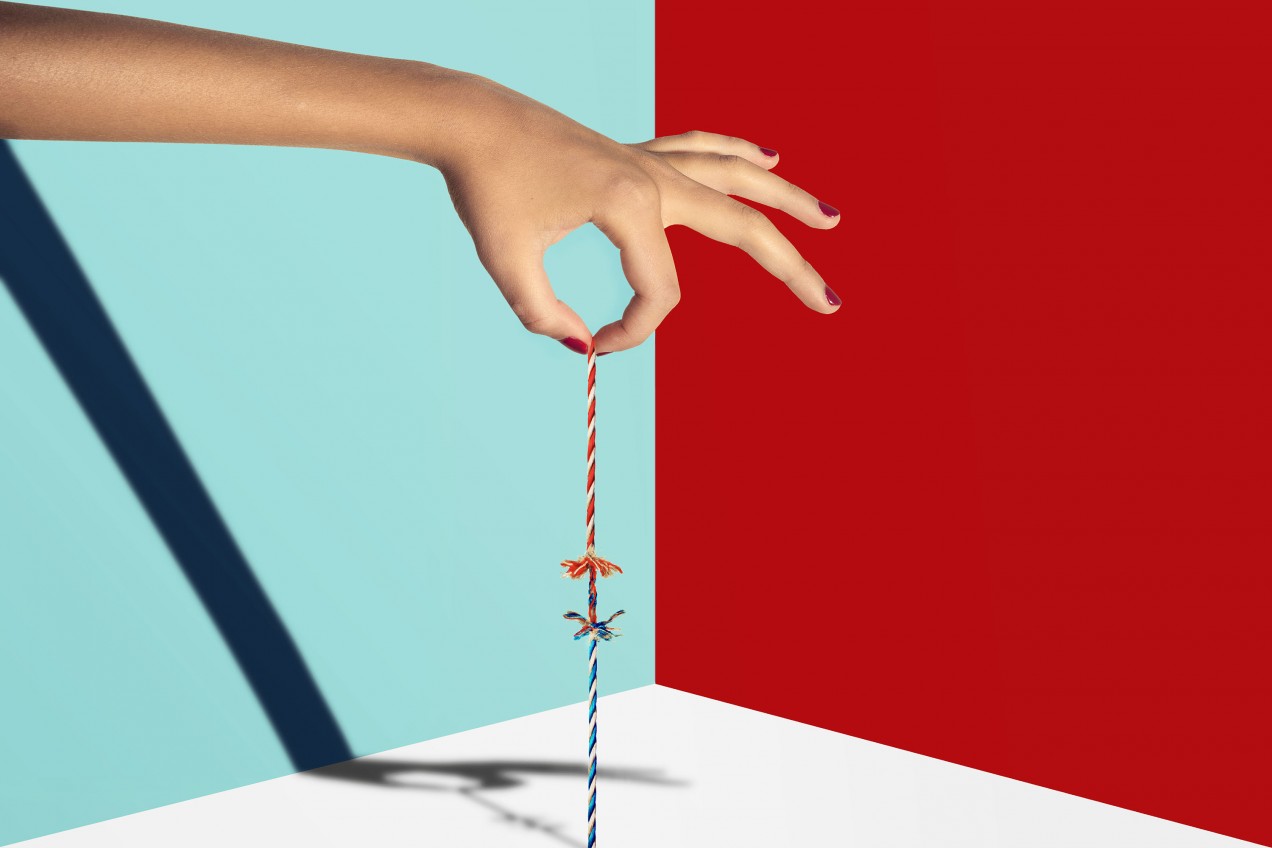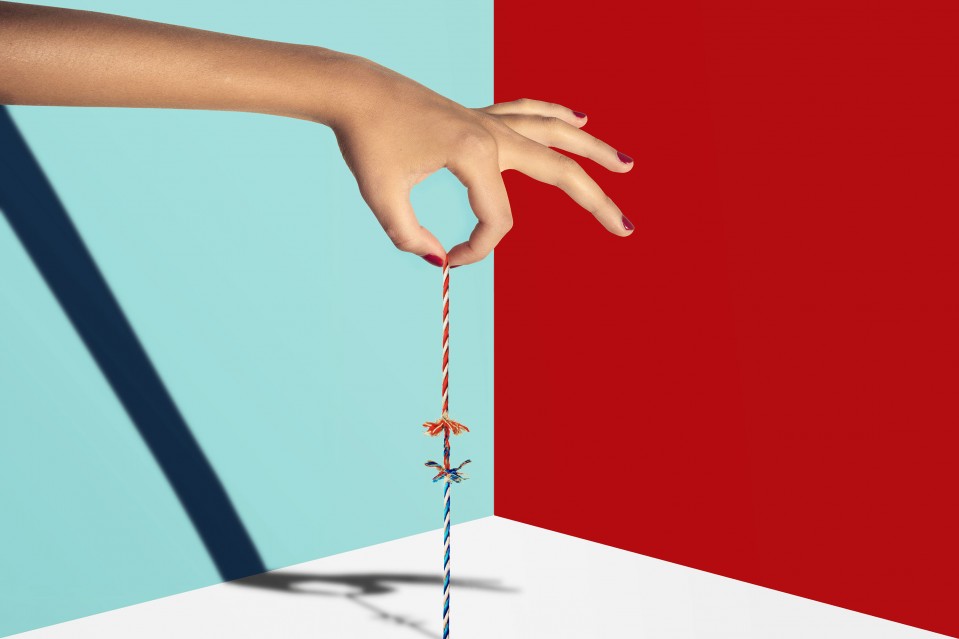

Humans and Technology
How a ban on pro-Trump patterns unraveled the online knitting world
When knitting site Ravelry banned all pro-Trump content it caused a schism in the community—but it also shone a spotlight on how women are using niche sites to politicize.

Last January, a New England woman was inspired to design a new beanie, commemorating the construction of President Donald Trump’s planned US border wall. Her knitting pattern spelled out “Build the Wall” with a brick motif. “Deplorable Knitter,” as she calls herself, then posted the pattern on Ravelry, the internet’s largest collective of knitters and crocheters.
The response was vitriolic. “Everyone was so angry about it,” she says.
But Deplorable Knitter, who’d previously just used the site to browse patterns, was fired up. When Trump announced he was running for reelection last June, she designed a Trump 2020 “Keep America Great” cowl. “That one blew up,” she says, describing threats and bullying that have forced her to remain anonymous. Her cowl pattern got flagged for hate speech, and on June 21, Deplorable Knitter was banned from Ravelry.
She was not alone. On June 23, the site banned “support of Donald Trump and his administration.” In a statement at the time, Ravelry said: “We cannot provide a space that is inclusive of all and also allow support for open white supremacy. Support of the Trump administration is undeniably support for white supremacy.”
The ban tore Ravelry apart, with opponents of the policy making a bitter exit while liberal supporters offered a flood of patterns featuring pride flags, donkeys, and anti-Trump phrases. It has also splintered the knitting world at large, with new, overtly political (and many right-wing) sites springing up to fill the gap.
But the infighting in one of the internet's most niche communities is about more than just politics and knitting. It’s a glimpse of how otherwise ignored populations—here, predominantly older women—are using online platforms to organize and make their voices heard. And the Ravelry falling-out highlights questions other platforms, like Facebook and Twitter, have tiptoed around: What constitutes hate speech, and how should censorship work online?
A decade of pattern-sharing
Ravelry boasts about 8.5 million registered users. Half a million of these are considered active, and there are 40,000 subgroups. The site is pretty ugly: its tab structure, font, and blocky formatting recall an earlier, simpler time on the internet when chat rooms reigned. It hasn’t updated its design since it launched in 2007.
The site originally started as a platform for knitters and crocheters to share their works in progress, swapping tips and selling patterns. Soon groups formed around other common interests. Some were silly; others focused on things certain users had in common, like being from a similar region or being a fan of a cult TV show. The most volatile and active groups, however, were political.
For some, the politicization of knitting groups started in earnest with the Women’s March in 2017. Thousands of women knitted “pussy hats” to protest the “grab ’em by the pussy” comment the president was revealed to have made in 2005. Nearly 5,000 knitters were active on Ravelry’s dedicated subgroup for the march. Three years later, a majority remained active, says Sandra Markus, a professor at the Fashion Institute of Technology. Together with Ioana Literat, a professor at Columbia University Teachers College, she published a paper last year that chronicles online “craftivism” and how politics has grown with it.
“The whole [pussy hat] project emerged in six weeks from Thanksgiving to New Year’s, and it was all online,” Markus says. “There was a level of effectiveness because people were dismissive of knitters as little gray-haired ladies. But when older women transgressed these boundaries with their knitting, the optics of police up against gray-haired women with balls of knitting were not good. Women were advocating and effective in online spaces.”
Much of the organization behind the scenes for the Women’s March and the “pussy hats” took place in the unmoderated spaces of Ravelry, where no entity controlled who saw what content. Unlike Facebook groups, which vet membership, Ravelry’s groups (used to) let anyone in. This meant the dialogue “gets much more controversial and contentious much faster,” says Markus.
But with the ban on Trump-related content, many of those voices moved elsewhere. In the eight months since the ban, a slew of right-leaning Ravelry copycats have sprung up. Deplorable Knitter launched her own site, subtitled “The Adventures of a Politically Incorrect Knitter,” where she’s gained a cult following and is currently hosting a knit-along of a hat and cowl emblazoned with “Women for Trump.” There’s the independent 18,000-strong Fiberkind, whose threaded chat layout most resembles Ravelry. And there’s Trump-supporting Freedom Knits, “where artistic freedom is respected.” It has grown to 400 members in the two months since it launched.
The increased politicization of the online knitting world has come as part of a demographic shift. While the community still skews older and mostly female, it is fast diversifying. Millennials—who are generally more politically active and came of age in the AIM chatroom—are now signing up to Ravelry and its offshoots. “They’ve been awakened in this particular moment to capitalize on their identity,” Literat says.
And it’s no longer just about the knitting patterns: sites like Ravelry offer a “safe space” for discussing politics. Deplorable Knitter and Medora Van Denburgh, who leads a 239-member Bernie Sanders group on Ravelry, both said that they live in regions that typically lean in the opposite political direction from their own, and Ravelry allowed them to feel less alone.
It’s something we will see more of, Literat predicts. Other niche groups she’s studied, such as Fortnite players and fan fiction sites, have created active subgroups around political conversation in much the same way. Typically, people feel safe engaging around the core interest first (in Ravelry’s case, knitting or crocheting), but increasingly delve into political discussions over time.
Online communities that are hyperspecific to certain hobbies also help engender dialogue across the political divide—a key point in a polarized political environment where people spend much of their time in ideological bubbles, says Literat.
“You get a much wider spectrum of opinions in these spaces,” she says. “You see people who are already politically engaged, but also people who aren’t coming to these places, at least at first, because of politics.”
Censorship vs free speech
Or they weren’t. Ravelry’s equation of Trump support with white supremacy is a controversial move, even for supporters of the ban. (Ravelry declined to comment for this story, and cofounder Cassidy Forbes told me in an email that the company “[doesn’t] really do press that isn’t part of the yarn industry—it’s not a new policy or anything, just something we’ve done for the last 13 years.”)
Pam Mauser, the founder of Freedom Knits, says she founded the site because she was insulted by Ravelry’s stance. “I knit a Trump 2020 hat, and they took it down with no notice,” says Mauser, an Indiana native. “They just sent me a message that it’s no longer acceptable. But what’s acceptable on the site is stuff that says ‘F--- Trump.’ It’s political.”
Mauser says her site welcomes both liberals and conservatives. “If you want to post about Obama, that’s perfectly fine,” she says. “It’s not political. It’s Freedom Knits. I don’t believe in censoring people who don’t believe the way you believe.”
On the other side of the aisle, Van Denburgh says the ban on Trump support wasn’t something that sat comfortably with her either. “I truly was stymied by the conflict between my principles [of free speech] and my grudging admission of the fact that Ravelry had done the right thing in enacting the ban,” she says.
The controversy shines a light on the future of political organizing: ultra-niche, small-but-vocal online communities built around an otherwise nonpolitical hobby or interest. For Literat, Ravelry’s ban presents a litmus test for the future of niche-site censorship and whether it’s best to forge a single, politically homogenous community or to splinter fringe users off.
It is also giving women a new way to become politicized online. For Amy Singer, the founder of another knitting site, Knitty, that’s good news.
“The one thing that crafts have always done is bring solace,” she says. “It gives us a way to express what’s upsetting us, hope for change, and bring comfort. Knitting’s not for grannies. We’re not scared any more.”
